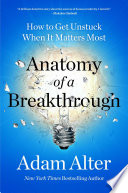

The book begins by dissecting the concept of breakthroughs, explaining that they are not just random acts of innovation but rather the result of a systematic approach to problem-solving. The authors emphasize that breakthroughs often stem from a deep understanding of the underlying issues at hand. By analyzing historical examples and contemporary case studies, they illustrate how successful innovators have identified specific pain points and leveraged them as opportunities for growth. This idea encourages readers to shift their perspective from viewing breakthroughs as mere luck to recognizing them as achievable through methodical exploration and inquiry.
Continue readingA significant theme in the book is the importance of mindset in achieving breakthroughs. The authors argue that a growth mindset, characterized by resilience and adaptability, is crucial for overcoming obstacles. They present studies that show how individuals and teams with a positive attitude toward challenges are more likely to innovate successfully. By fostering a culture that embraces learning from failure and encourages experimentation, organizations can create an environment conducive to breakthroughs. This idea serves as a reminder that the right mindset can be a powerful catalyst for innovation.
Continue readingThe authors highlight the necessity of collaboration and diversity in the innovation process. They argue that breakthroughs often occur at the intersection of different disciplines and perspectives. By bringing together individuals with varied backgrounds, experiences, and expertise, organizations can foster creative thinking and generate novel solutions. The book provides examples of successful collaborations that led to groundbreaking innovations, demonstrating how diverse teams can tackle complex problems more effectively than homogenous groups. This idea underscores the value of inclusivity and teamwork in driving progress.
Continue readingAnother key concept discussed in the book is the practice of iterative prototyping. The authors advocate for a hands-on approach to innovation, where ideas are quickly transformed into tangible prototypes that can be tested and refined. This iterative process allows teams to gather feedback early and often, enabling them to pivot their strategies based on real-world insights. The book illustrates this idea with case studies from tech companies that have successfully adopted agile methodologies, showcasing how rapid prototyping can accelerate the path to breakthrough innovations.
Continue readingThe authors emphasize the importance of embracing failure as an integral part of the innovation journey. They argue that fear of failure can stifle creativity and hinder progress. By reframing failure as a learning opportunity, organizations can encourage risk-taking and experimentation. The book provides anecdotes from innovators who have faced setbacks but ultimately used those experiences to fuel their breakthroughs. This idea serves as a powerful reminder that failure is not the opposite of success but rather a stepping stone toward achieving it.
Continue readingA critical aspect of achieving breakthroughs is understanding and prioritizing the needs of customers. The authors stress that innovation should be driven by a deep empathy for users, leading to solutions that genuinely address their problems. They advocate for techniques such as user interviews, surveys, and observation to gather insights into customer pain points. By placing the customer at the center of the innovation process, organizations can create products and services that resonate with their target audience, increasing the likelihood of successful breakthroughs.
Continue readingFinally, the book discusses the importance of sustaining innovation over time. The authors argue that achieving a breakthrough is just the beginning; organizations must also develop strategies to maintain momentum and continue innovating. They provide frameworks for creating a culture of continuous improvement and emphasize the need for ongoing investment in research and development. This idea highlights that innovation is not a one-time event but a continuous journey that requires commitment and adaptability.
Continue reading